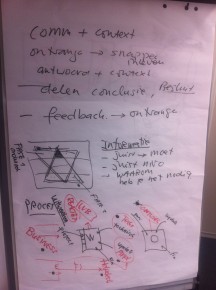Improving Information Management performance (part 2)
This blog describes the approach and the results of an Information Management improvement program. It shows how a business simulation was used to both gain understanding about BISL (Business Information Services Library), and how to successfully use this to improve Information management. This is the second blog in a series of 5.
In the first blog I explained how we performed the intake and design for a customer’s request. In this blog I will demonstrate how we customized the setup of the simulation during an intake interview with the customer.
Part 2 : Intake and making it fit.
The Intake
With the team of co-trainers and the manager we had a 3 hour meeting. The general question was:
“How do we all see our department acting in 3 months from now?”
My role was simple:
- Challenge the team to describe the desirable behaviors that need to be realized. This needed to be clear and fully understood by the whole team. Example questions:
- What do you mean with “Good” or “Fast” or “We” or “They” or “Management”….?
- Why do you want to see this behavior?
- How does this behavior support the goals of your team?
- To ensure that there was a full commitment within the team.
- “Do we all agree?”
- “I see you are not sure and show doubts, explain your thoughts”
- “Why is it so difficult to agree?”
- Focus on realistic targets for the 3 month horizon and the results to be achieved using the simulation.
- Manage time
- Make sure that all information is available to document the learning process during the simulation.
Desirable Situation ‘Information Management in our company.
To give you an idea of the outcome of this session I will show you some of the key bullets from this ‘Wish document‘:
- Information between different roles are shared in such a way that everybody can do his work
 according to the agreements with the customer
according to the agreements with the customer - If a task is not clear, the receiver will ask for clarification and the sender will explain. The other way around, if the sender discovers that a task is not clear, he will ask and explain.
- The Information Manager will explore every month the new Business demands or ideas and together with the IT manager analyses the consequences on planning and Information Strategy, as well as the IT Strategy. Consequences are reported back to the Business.
- The information analyst will analyze each Business requirement in such a way that he knows all the technology consequences, application consequences and information consequences. He translates this into a realistic feedback to the Business.
- The IT Manager and Information Manager will avoid constraints on the Change Calendar or Development Planning, by planning proactively, based on the information they receive from the Information Analyst, Functionality Manager and other roles in the team.
- We all need to act on the three levels and stay consistent on those three levels.
| Level | Roles | Key Actions |
| Strategic |
|
Make long term plansExplore business demandExplore opportunities and threats |
| Tactical |
|
Explore technical impact of new demandsOrganize the activities and plan them |
| Operational |
|
Execute implementation tasksSupport the usersUpdate and improve functionality |
I like this session, i get a clear picture of what we get out from this simulation, and i understand the work we need to do after the simulation
Final offer – Design of the simulation and follow up
Remember this is just a short reflection of the intake. After this intake a prepared the final offer. This offer contains the following structure and content:
What is the problem/goal
- Improve the performance of the chain from Business to IT
- Improve the performance of the Information Management Roles in both teams, the Information Management team and the IT delivery team
- Support the business with the right information, on the right time and the right quality
- Session with the team of employees to teach them how to CO-facilitate the simulation with our trainer.
- Organize 6 BookStore™ simulations, each with 12 employees from different roles in the chain to learn from each other, to learn how to organize the chain, control the chain, execute the chain and improve the performance.
- The CO-facilitator will facilitate on the day-to-day work experience and will help the team to explore and link the experience to action after the simulations.
- CO-facilitators will use the ‘Wish document‘ as a guidance for improvement activities:
- During meetings, to talk about it and reflect on it to make improvement suggestions
- During service execution, to give feedback and improve
- During project closure, to evaluate and improve projects
- During all kind of short meetings to give feedback to every employee
- Execute 3 sessions after the simulations with the CO-facilitators to support them with the transfer of the knowledge from the simulations to day to day work. This session is based on Action Learning.
- Execute a measurement process in order to measure the progress of the ‘Desirable behavior’. “Do we all see us moving towards the goals we set during the intake?”. But also we perform some surveys to measure and steer.
